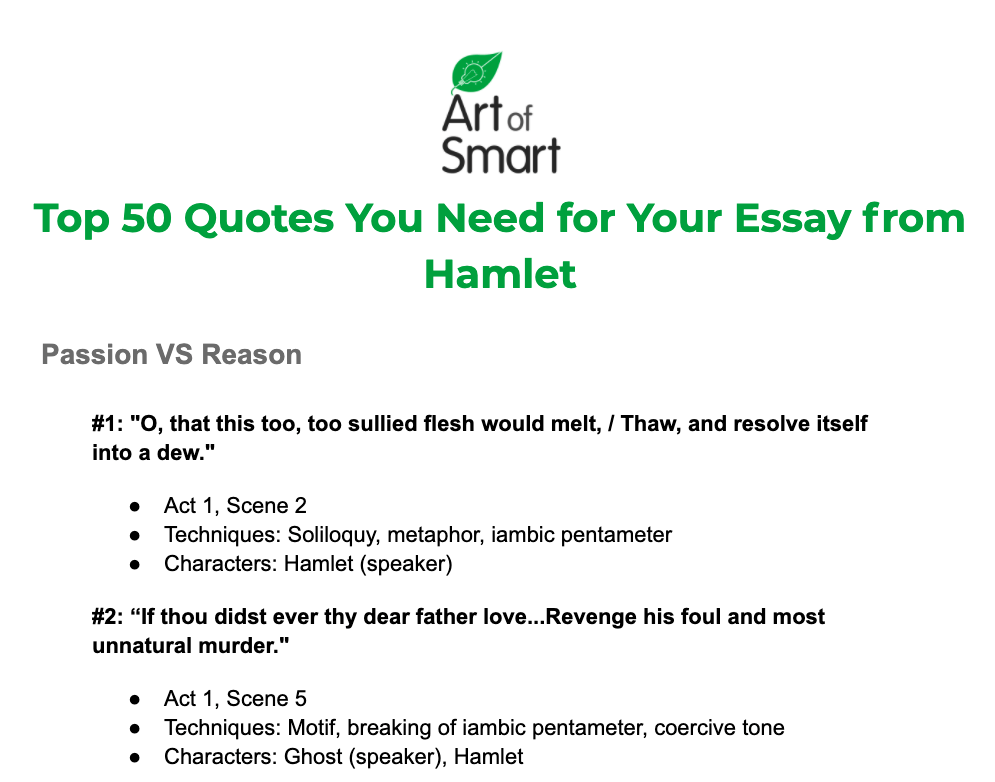Have to write up an essay on Hamlet, but are struggling to pick quotes to analyse?
Guess what? We’ve come up with exactly what you need — a list of 50 quotes spread across 5 different themes that can help to inspire your ideas when writing about Hamlet.
Keep reading to discover the best quotes you’ll want to remember!
Passion VS Reason
Appearance VS Reality
Hamlet Quotes about Philosophy – Freewill VS Determinism
Corruption
Gender Imbalance
Passion VS Reason
#1: “O, that this too, too sullied flesh would melt, / Thaw, and resolve itself into a dew.”
- Act 1, Scene 2
- Techniques: Soliloquy, metaphor, iambic pentameter
- Characters: Hamlet (speaker)
Analysis:
It reflects Hamlet’s state of mind, which is filled with despair and a sense of hopelessness. The phrase “O, that this too, too sullied flesh would melt” can be interpreted as an expression of Hamlet’s desire to escape the troubles that surround him, including his father’s death, his mother’s remarriage, and his own sense of disillusionment with the world.
The word “sullied” suggests that Hamlet sees his own physical form as tainted or impure. The fact that he wishes for his flesh to “melt, Thaw, and resolve itself into a dew” suggests a desire for release from his physical body and his earthly troubles. The metaphor of melting and turning into dew implies a transformation or purification, as if Hamlet longs to shed his human form and become something more ethereal and pure.
Overall, this quote captures the sense of despair and disillusionment that Hamlet feels at the beginning of the play. It sets the tone for his journey throughout the rest of the play as he grapples with issues of life, death, and morality.
#2: “If thou didst ever thy dear father love…Revenge his foul and most unnatural murder.”
- Act 1, Scene 5
- Techniques: Motif, breaking of iambic pentameter, coercive tone
- Characters: Ghost (speaker), Hamlet
#3: “O, what a rogue and peasant slave am I!”
- Act 2, Scene 2
- Techniques: Contrast, exclamation
- Characters: Hamlet (speaker)
Analysis:
The line expresses Hamlet’s feelings of self-loathing and inadequacy. He is calling himself a “rogue” and a “peasant slave,” meaning that he feels like a low-born, dishonest person, and a servant or slave to his own base desires.
The line is often interpreted as a manifestation of Hamlet’s internal struggle and his distress over his own inability to act on his desires and bring about revenge for his father’s murder. Hamlet is feeling a sense of worthlessness and feels like he is a slave to his own weaknesses.
#4: “So, as a painted tyrant, Pyrrhus stood, / And like a neutral to his will and matter, / Did nothing”
- Act 2, Scene 2
- Techniques: Mythological allusion, breaking of iambic pentameter, dramatic foil (to Hamlet)
- Characters: First player (speaker), the Court
#5: “the play’s the thing / Wherein I’ll catch the conscience of the king.”
- Act 2, Scene 3
- Techniques: Rhyme, metafiction, consonance
- Characters: Hamlet (speaker)
#6: “The spirit that I have seen / May be the devil: and the devil hath power / To assume a pleasing shape”
- Act 3, Scene 2
- Techniques: Biblical allusion, consonance, blank verse
- Characters: Hamlet (speaker)
Analysis:
Hamlet is expressing his uncertainty and fear that the ghost may not be a benign spirit, but rather a deceitful entity with the ability to appear attractive and alluring. The quote highlights Hamlet’s uncertainty about the true nature of the ghost, and his suspicion that it may be a malicious entity with the power to manipulate and deceive.
This line is often seen as an example of Hamlet’s philosophical and introspective nature, as well as his skepticism about the motivations of the ghost and his willingness to question the supernatural events he witnesses.
#7: “How all occasions do inform against me, / And spur my dull revenge!”
- Act 4, Scene 4
- Techniques: Hyperbole, soliloquy, exclamation
- Characters: Hamlet (speaker)
#8: “but one part wisdom/ And ever three parts coward”.
- Act 4, Scene 4
- Techniques: Contrast
- Characters: Hamlet (speaker)
#9: “My thoughts be bloody, or be nothing worth!”
- Act 4, Scene 4
- Techniques: Repetition, parallelism
- Characters: Hamlet (speaker)
Analysis:
It reflects Hamlet’s intense desire for revenge against his uncle Claudius, who he believes has murdered his father and taken his throne. The phrase “My thoughts be bloody, or be nothing worth!” can be interpreted as an expression of Hamlet’s determination to follow through with his plan for revenge, regardless of the consequences.
The word “bloody” suggests that Hamlet is willing to resort to violence in order to achieve his goal. He is so consumed by his desire for revenge that he is willing to risk everything, including his own life, to make it happen. The phrase “or be nothing worth!” emphasises the seriousness of Hamlet’s commitment to this course of action. For him, if he does not follow through with his plan for revenge, his thoughts and his very existence would be meaningless.
Overall, this quote captures the sense of desperation and determination that drives Hamlet’s actions throughout the play. It also reflects the underlying theme of the play, which is the corrupting influence of revenge and the destructive consequences that can result from it.
#10: “Conscience and grace to the profoundest pit / I dare damnation”
- Act 4, Scene 5
- Techniques: Biblical allusion, alliteration, dramatic foil
- Characters: Laertes (speaker), King Claudius
#11: “[Revenge] warms the very sickness of my heart”
- Act 4, Scene 7
- Techniques: Dramatic foil, personification
- Characters: Laertes (speaker), King Claudius
#12: “To cut his throat I’ the church”
- Act 4, Scene 7
- Techniques: Parataxis, truncated sentence, declarative tone
- Characters: Laertes (speaker), King Claudius, Hamlet
Appearance VS Reality
#13: “With mirth in funeral and dirge in marriage”
- Act 1, Scene 2
- Techniques: Antithesis, paradox, contrast
- Characters: King Claudius (speaker), Gertrude
#14: “Why seems it so particular with thee?”
- Act 1, Scene 2
- Techniques: Euphemism, motif
- Characters: Queen Gertrude (speaker), Hamlet
#15: “This above all, to thine own self be true.”
- Act 1, Scene 3
- Techniques: Irony
- Characters: Polonius (speaker), Laertes
#16: “The will of my most seeming-virtuous queen”
- Act 1, Scene 5
- Techniques: Motif, characterisation
- Character: Ghost (Speaker), Hamlet
#17: “The serpent that did sting thy fathers life / Now wears his crown”
- Act 1, Scene 5
- Techniques: Metaphor, biblical reference
- Characters: Ghost (speaker), King Claudius, Hamlet
#18: “To put an antic disposition on,”
- Act 1, Scene 5
- Techniques: Euphemism, foreshadowing
- Characters: Hamlet (speaker)
#19: “I am but mad north-north-west. When the wind is southerly, / I know a hawk from a handsaw”
- Act 2, Scene 2
- Techniques: Free verse, repetition, consonance
- Characters: Hamlet (speaker), Polonius, Rosencrantz and Guildenstern
#20: “Madness in great ones must not unwatched go”
- Act 3, Scene 1
- Techniques: Metonymy
- Characters: King Claudius (speaker), Polonius
#21: “Do it, England; / For like the hectic in my blood he rages / And thou must cure me”
- Act 4, Scene 3
- Techniques: Simile, metonymy
- Characters: King Claudius (speaker)
#22: “Laertes was your father dear to you? / Or are you like a painting of a sorrow, / A face without a heart?”
- Act 4, Scene 7
- Techniques: Dramatic foil, metaphor, rhetorical question, coercive tone
- Characters: King Claudius (speaker), Laertes
Hamlet Quotes about Philosophy – Freewill VS Determinism
#23: “What if it tempt you toward the flood, my lord, / Or to the dreadful summit of the cliff…deprive your sovereignty of reason and draw you into madness?”
- Act 1, Scene 4
- Techniques: Foreshadowing, metaphor, iambic pentameter
- Characters: Horatio (Speaker), Ghost, Hamlet
#24: “The time is out of joint: O cursed spite, / that I was born to ever set it right!”
- Act 1, Scene 5
- Techniques: Rhyme, symbolism
- Characters: Hamlet (speaker)
#25: “What a piece of work is a man, how noble in reason…—and yet, to me, what is this quintessence of dust?”
- Act 2, Scene 2
- Techniques: Rhetorical question, memento mori (“dust”)
- Characters: Hamlet (speaker)
Analysis:
Hamlet is marvelling at the complexity and capabilities of human beings, but also questioning their ultimate worth and significance. The phrase “quintessence of dust” is a metaphor for the fleeting and transitory nature of human life.
Hamlet is considering the dichotomy between the seemingly limitless potential of human reason and the ultimate mortality of all living beings. The line is often seen as a testament to Hamlet’s philosophical and introspective nature, as well as his search for meaning in the face of mortality.
The quote is widely regarded as one of Shakespeare’s most famous musings on the human condition.
#26: “To die, to sleep; To sleep: perchance to dream”
- Act 3, Scene 1
- Techniques: Tricolon, metaphor (“dream”)
- Characters: Hamlet (speaker)
#27: “Whether ’tis nobler in the mind to suffer/The slings and arrows of outrageous fortune,/Or to take arms against a sea of troubles/And, by opposing, end them.”
- Act 3, Scene 1
- Techniques: Soliloquy, metaphor
- Characters: Hamlet (speaker)
#28: “Imperious Caesar, dead and turned to clay,/ might stop a hole, to keep the wind away”
- Act 5, Scene 1
- Techniques: Historical allusion, rhyme, iambic pentameter
- Characters: Hamlet (speaker), Horatio
#29: “Alas, poor Yorick! I knew him, Horatio: a fellow of infinite jest,… Where be your gibes now? your/gambols? your songs? your flashes of merriment that were wont to set the table on a roar?”
- Act 5, Scene 1
- Techniques: Memento mori, free verse, caesura
- Characters: Hamlet (speaker), Yorick, Horatio
#30: “Is’t not to be damned/ To let this canker of out nature come / in further evil?”
- Act 5, Scene 2
- Techniques: Metaphor, biblical reference
- Characters: Hamlet (speaker), Horatio
#31: “There’s a divinity that shapes our ends”
- Act 5, Scene 2
- Techniques: Biblical reference, double entendre (“ends”)
- Characters: Hamlet (speaker), Horatio
Analysis:
Hamlet is suggesting that there is a force beyond human control that shapes our lives and determines the outcome of our actions. The word “divinity” refers to a god or gods, implying that this shaping power may be divine in nature.
The line is often seen as an expression of Hamlet’s belief in a greater purpose or destiny guiding the events of the world. It is also interpreted as a commentary on the idea of predestination, which holds that the future is set and cannot be altered by human actions.
The quote is considered one of Shakespeare’s most famous expressions of the idea of fate and its role in shaping human lives.
#32: “There’s a special / providence in a fall of a sparrow”
- Act 5, Scene 2
- Techniques: Biblical reference, metaphor, metonym
- Characters: Hamlet (speaker), Horatio
#33: “The rest is silence.”
- Act 5, Scene 2
- Techniques: Parataxis, metaphor
- Characters: Hamlet (speaker), Horatio
Corruption
#34: “And I am sick at heart”
- Act 1, Scene 1
- Techniques: Metaphor, motif
- Characters: Fransisco (speaker), Bernardo
#35: “’tis an unweeded garden/which grows to seed things rank and gross in nature”
- Act 1, Scene 2
- Techniques: Biblical reference (to Eden), metaphor, free verse
- Characters: Hamlet (speaker)
#36: “Something is rotten in the state of Denmark”
- Act 1, Scene 4
- Techniques: Metaphor
- Characters: Marcellus (speaker)
Analysis:
Marcellus is using the phrase “something is rotten” to suggest that there is a pervasive sense of corruption or decay in the state, and that something is deeply wrong with the political and social order. The line is often interpreted as a commentary on the moral decay and corruption present in the court of Denmark, as well as a broader critique of political and societal institutions.
The quote has become one of Shakespeare’s most famous expressions of the idea that something is amiss in a particular place or situation. It is often used in a general sense to describe a situation where there is an underlying sense of corruption or decay, regardless of the specific context or location.
#37: “But two months dead!…So excellent a king; that was, to this, Hyperion to a satyr; so loving to my mother”
- Act 1, Scene 2
- Techniques: Hyperbole, mythological allusion
- Characters: Hamlet (speaker)
#38: “You were sent for – and/ there is a kind of confession in your looks which your modesties/ have not craft enough to colour. I know the good king and queen have sent for you.”
- Act 2, Scene 2
- Techniques: Free verse, consonance
- Characters: Hamlet (Speaker), Rosencrantz and Guildenstern
#39: “O, villain, villain, smiling, damnèd villain!”
- Act 1, Scene 5
- Techniques: Diacope
- Characters: Hamlet (speaker)
Analysis:
Hamlet is expressing his anger and frustration at Rosencrantz’s treachery, as well as his disbelief that someone he trusted could betray him in such a manner. The phrase “smiling, damnèd villain” is an expression of Hamlet’s shock and disbelief at Rosencrantz’s seemingly cheerful demeanour in the face of his treachery.
Hamlet is suggesting that the smile on Rosencrantz’s face makes his betrayal all the more treacherous, as it suggests that he is taking pleasure in his actions.
The line is often seen as a commentary on the theme of betrayal in “Hamlet,” as well as a testament to Hamlet’s capacity for anger and bitterness in the face of disappointment. It is considered one of the most memorable expressions of anger and betrayal in Shakespeare’s works.
#40: “My words fly up, my thoughts remain below/Words without thoughts never to heaven go”
- Act 3, Scene 3
- Techniques: Rhyme, iambic pentameter
- Characters: King Claudius (speaker)
#41: “Here is your husband; like a mildew’d ear, / Blasting his wholesome brother.”
- Act 3, Scene 4
- Techniques: Simile, contrast
- Characters: Hamlet (speaker), King Claudius, King Hamlet, Gertrude
#42: “Now cracks a noble heart. Good night, sweet prince/And flights of angels sing thee to thy rest.”
- Act 5, Scene 2
- Techniques: Metaphor, biblical reference
- Characters: Horatio (speaker), Hamlet
Gender Imbalance Quotes from Hamlet
#43: “Frailty, thy name is woman!”
- Act 1, Scene 2
- Techniques: Dramatic irony, exclamation
- Characters: Hamlet (speaker), Queen Gertrude
#44: “Affection? Pooh! /You speak like a green girl,”
- Act 1, Scene 3
- Techniques: Symbolism of green
- Characters: Polonius (speaker), Ophelia
#45: “What’s Hecuba to him, or he to Hecuba/That he should weep for her?”
- Act 2, Scene 2
- Techniques: Dramatic contrast, mythological reference
- Characters: Hamlet (speaker), Queen Gertrude
- Characters: Hamlet (speaker), Ophelia
#46: “I’ll loose my daughter to him”
- Act 2, Scene 2
- Techniques: Objectification
- Characters: Polonius (speaker), Ophelia
Analysis:
Polonius is speaking about his daughter Ophelia and her relationship with Hamlet. The phrase “I’ll loose my daughter to him” can be interpreted as an expression of Polonius’ willingness to allow Ophelia to pursue a romantic relationship with Hamlet, despite his reservations about Hamlet’s intentions.
The word “loose” suggests that Polonius sees Ophelia as something to be released or given away, rather than as an independent individual with her own desires and agency. The fact that Polonius is willing to “loose” his daughter to Hamlet also reveals his desire for social advancement and political power. By aligning himself with Hamlet, Polonius hopes to gain favor with the king and increase his own influence at court.
Overall, this quote reflects the complex power dynamics and social expectations at play in the world of ‘Hamlet.’ It also highlights the ways in which fathers, particularly those in positions of power, may use their daughters as pawns in their own political games.
#47: “Get thee to a nunnery! Why wouldst thou be a breeder of sinners?”
- Act 3, Scene 1
- Techniques: Innuendo, rhetorical question, double entendre
#48: “Nay, but to live / In the rank sweat of an enseamed bed / Stew’d in corruption, honeying and making love / Over the nasty sty,”
- Act 3, Scene 4
- Techniques: Metaphor, contrast
- Characters: Hamlet (speaker), Queen Gertrude, King Claudius
#49: “There’s rosemary, that’s for remembrance; pray, love, remember: and there is pansies. that’s for thoughts.”
- Act 4, Scene 5
- Techniques: Symbolism, tricolon
- Characters: Ophelia (speaker), King Claudius
#50: “for shame! Young men will do’t…they are to blame”
- Act 4, Scene 5
- Techniques: Rhyme
- Characters: Ophelia (speaker)
Analysis:
It is a commentary on the actions of young men and their tendency towards impulsive and reckless behaviour. The phrase “for shame” is an expression of disapproval or condemnation, while the reference to “young men” suggests that this impulsive and reckless behaviour is a particular problem among the young.
The line is often interpreted as a criticism of the irresponsibility and lack of judgement that is often associated with youth. It suggests that young men are prone to engaging in dangerous and irresponsible behaviour, and that this behaviour is a source of shame and blame for the community.
The concept is often seen as a commentary on the broader themes of youth and age in “Hamlet,” and a reflection of the societal attitudes towards young people during Shakespeare’s time. The line is considered one of the most memorable expressions of criticism in Shakespeare’s works, and continues to be relevant today as a commentary on the challenges faced by young people in society.
On the hunt for quotes from other texts aside from Hamlet?
Check out our list of quotes for the following texts:
- Frankenstein
- Lord of the Flies
- Blade Runner
- Pride and Prejudice
- The Stranger
- To Kill a Mockingbird
- Never Let Me Go
- The Curious Incident of the Dog in the Night-Time
- The Crucible
We’ve also got articles specifically on plays written by Shakespeare which you can access below:
- The Merchant of Venice
- Romeo and Juliet
- The Tempest
- Much Ado About Nothing
- Othello
- King Lear
- Macbeth
- A Midsummer Night’s Dream
Are you looking for some extra help with your Hamlet analysis of quotes?
We have an incredible team of English tutors and mentors!
We can help you master your analysis of Hamlet by taking you through the summary, key characters, quotes and themes. We’ll also help you ace your upcoming English assessments with personalised lessons conducted one-on-one in your home or online!
Studying Hamlet in Victoria? Our awesome Hamlet-obsessed tutors in Essendon will help you nail your assessments!
We’ve supported over 8,000 students over the last 11 years, and on average our students score mark improvements of over 20%!
To find out more and get started with an inspirational English tutor and mentor, get in touch today or give us a ring on 1300 267 888!
Lynn Chen is a Content Writer at Art of Smart Education and is a Communication student at UTS with a major in Creative Writing. Lynn’s articles have been published in Vertigo, The Comma, and Shut Up and Go. In her spare time, she also writes poetry.









